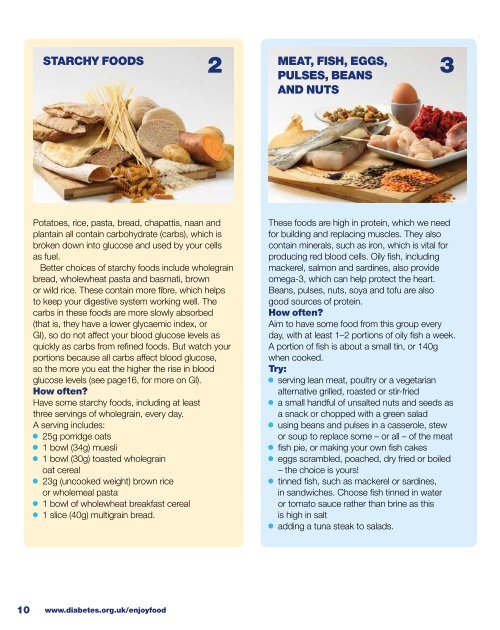Enjoy food
9f7d301hoGi
9f7d301hoGi
You also want an ePaper? Increase the reach of your titles
YUMPU automatically turns print PDFs into web optimized ePapers that Google loves.
STARCHY FOODS<br />
2 3<br />
MEAT, FISH, EGGS,<br />
PULSES, BEANS<br />
AND NUTS<br />
Potatoes, rice, pasta, bread, chapattis, naan and<br />
plantain all contain carbohydrate (carbs), which is<br />
broken down into glucose and used by your cells<br />
as fuel.<br />
Better choices of starchy <strong>food</strong>s include wholegrain<br />
bread, wholewheat pasta and basmati, brown<br />
or wild rice. These contain more fibre, which helps<br />
to keep your digestive system working well. The<br />
carbs in these <strong>food</strong>s are more slowly absorbed<br />
(that is, they have a lower glycaemic index, or<br />
GI), so do not affect your blood glucose levels as<br />
quickly as carbs from refined <strong>food</strong>s. But watch your<br />
portions because all carbs affect blood glucose,<br />
so the more you eat the higher the rise in blood<br />
glucose levels (see page16, for more on Gl).<br />
How often?<br />
Have some starchy <strong>food</strong>s, including at least<br />
three servings of wholegrain, every day.<br />
A serving includes:<br />
• 25g porridge oats<br />
• 1 bowl (34g) muesli<br />
• 1 bowl (30g) toasted wholegrain<br />
oat cereal<br />
• 23g (uncooked weight) brown rice<br />
or wholemeal pasta<br />
• 1 bowl of wholewheat breakfast cereal<br />
• 1 slice (40g) multigrain bread.<br />
These <strong>food</strong>s are high in protein, which we need<br />
for building and replacing muscles. They also<br />
contain minerals, such as iron, which is vital for<br />
producing red blood cells. Oily fish, including<br />
mackerel, salmon and sardines, also provide<br />
omega-3, which can help protect the heart.<br />
Beans, pulses, nuts, soya and tofu are also<br />
good sources of protein.<br />
How often?<br />
Aim to have some <strong>food</strong> from this group every<br />
day, with at least 1–2 portions of oily fish a week.<br />
A portion of fish is about a small tin, or 140g<br />
when cooked.<br />
Try:<br />
• serving lean meat, poultry or a vegetarian<br />
alternative grilled, roasted or stir-fried<br />
• a small handful of unsalted nuts and seeds as<br />
a snack or chopped with a green salad<br />
• using beans and pulses in a casserole, stew<br />
or soup to replace some – or all – of the meat<br />
• fish pie, or making your own fish cakes<br />
• eggs scrambled, poached, dry fried or boiled<br />
– the choice is yours!<br />
• tinned fish, such as mackerel or sardines,<br />
in sandwiches. Choose fish tinned in water<br />
or tomato sauce rather than brine as this<br />
is high in salt<br />
• adding a tuna steak to salads.<br />
10<br />
www.diabetes.org.uk/enjoy<strong>food</strong>


